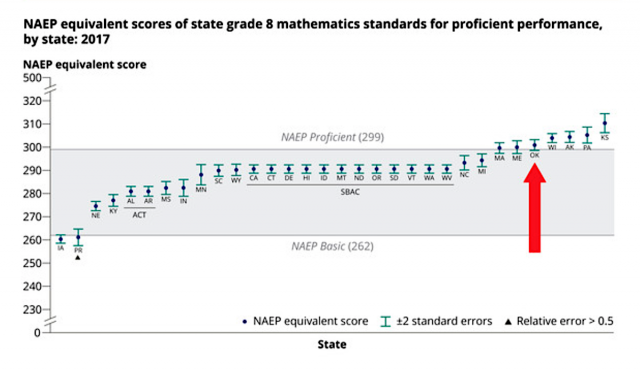
The 2019 Oklahoma school report cards are in, and they bring bad news. Over time, I will be digging deeply into the numbers and seeking nuance. For now, however, a most important issue with the school grades must be kept in mind: The outcomes aren’t nearly as bad as they seem.
The statistics released Monday show the state’s grade for “academic achievement” dropped from a “C” (earning 18.1 out of 35 points) to a “D” (earning 17.6 of 45 points). The score for the number of students prepared for the next grade fell from 52 percent to 39 percent. The points earned for English scores dropped from 6.7 (out of a possible 15 points) to 5.4. math points dropped from 6.3 to 5.2 points. The good news is that “academic growth” scores increased by 9 points.
Oklahoma school report cards
Search results here
The Oklahoma City Public Schools earned a 0.9 out of 35 points for academic achievement, down from 1.3 in 2018. Academic growth points remained stable. OKCPS’ math proficiency rates also remained stable overall, but economically disadvantaged students’ proficiency rates dropped 20 percent.
We should all take a deep breath, however, and not assume that those metrics are meaningful. To understand why, let’s focus predominantly on the math standards.
New standards provide ‘top 10’ metric, but please be realistic
As State Superintendent of Public Instruction Joy Hofmeister explained recently, she took office in 2015 and was tasked with replacing Common Core standards and tests with new, rigorous standards and assessments. To her credit, Hofmeister has not supported high stakes testing. But politically speaking, it is easy to see why she implemented tests difficult enough to be called the pathway to a “top 10” education system.
The State Department of Education listened to teachers, who also support higher standards, as well as corporate reformers, such as the conservative Fordham Institute, which claimed Oklahoma’s standards were “weak.” The state previously ranked 47th and received a ‘D’ on Fordham’s grade cards. The Hofmeister administration’s new standards place Oklahoma in their top one-third of the nation. The new 8th grade math standards are ranked as the nation’s fifth toughest.
The OSDE also touts the new NAEP mapping study which documents the redefining of “proficiency.” Oklahoma’s 2017 8th grade math tests set a proficiency level which is at the NAEP proficiency level, basically comparable to around a 300 on that rigorous standard.
This remapping supposedly “confirm(s) our belief that Oklahoma students can compete with kids anywhere in the country,” Hofmeister said in an August press release. But who has actually risen to that standard?
The only groups in the United States where average scores reach that level are white and economically advantaged students in Massachusetts, a state where per capita income is nearly 50 percent greater than in Oklahoma. Meanwhile, Oklahoma’s NAEP scores currently correlate with a level just above Kazakhstan. Advantaged students in Massachusetts perform at the level of their counterparts on PISA and TMMS in the top performing states and nations, except for South Korea.
Of course, now that we have listened to conservative reformers at the Fordham Institute and raised our expectations, Oklahoma students will soon join those students at the top of the world’s education systems and rival South Korea as the globe’s highest-performing, right?
Sarcasm aside, even measured by these incredibly rigorous assessments, Oklahoma schools likely are doing pretty well, given the obstacles they face. If funding is restored, and if schools continue to liberate themselves from test and punish, while tackling the worthy challenges of reducing chronic absenteeism and implementing trauma-based instruction, the state’s future looks OK.
It makes no sense to expect poor children in our grossly underfunded, highest-poverty urban schools to measure up to the new definition of proficiency. But those who want one headline after another about “failing” schools are not going away, so perhaps we should be thankful the OSDE hasn’t had to return to the era of test and punish.
The reasons for setting impossible test score targets never made sense educationally, but they are a political fact of life. We should ignore the forces that pressure education leaders into adopting such metrics, blow off the negative headlines from Oklahoma school report cards and get to work toward meaningful instruction for our state’s poorest children.





















